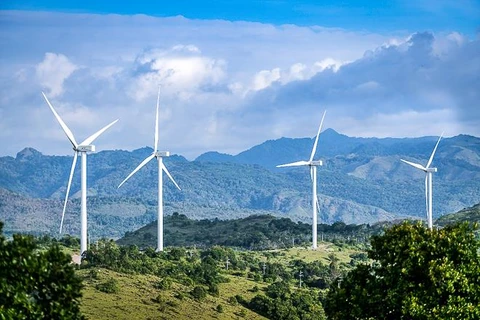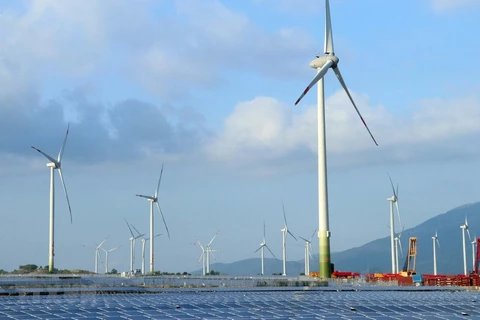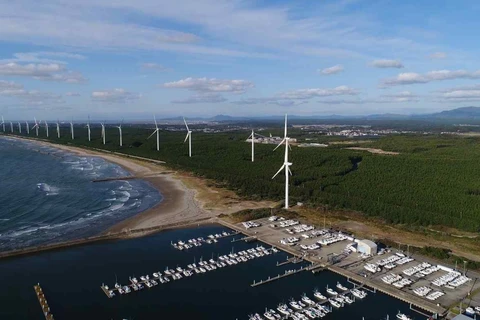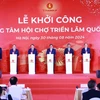Hanoi (VNS/VNA) - The Ministry of Industry and Trade (MoIT) needs to study and direct Vietnam Electricity (EVN) to issue regulations on the transmission and distribution system to ensure the stable operation of the power system amid abundant wind and solar power sources, said Tran Viet Ngai, Chairman of the Vietnam Energy Association.
He said the ministry should also develop energy storage systems (ESS), stored hydroelectricity to be synchronised with renewable energy development.
One of the difficulties to develop wind and solar power in the Draft Power Plan VIII is to ensure the construction of a synchronised and stable grid system. Projects that combine offshore wind power with green hydrogen production with a large enough scale bring a new approach for both domestic and export to international market, a viable solution that is applied and accelerated in many countries.
Nguyen Viet Anh, Vice President of the German-Vietnamese Innovative Network, said: “Hydrogen will be an important foundation to provide stable and sustainable energy for Vietnam and an important foundation in National Power Planning VIII. However, the necessary condition here is to continue to expand and improve the existing infrastructure through international programmes and cooperation.”
Green hydrogen is produced using renewable energy to provide electrolysed energy - separating water molecules into hydrogen and oxygen, which is strongly developed to replace fossil fuels, serving the production, storage of electricity, industry, transportation, fertiliser production and chemicals.
According to analysts of Fitch Solutions, global annual hydrogen demand is forecast to increase from about 80 million tonnes in 2021 to 100 million tonnes by 2030. The green hydrogen sector could produce about 10 million tonnes per year by 2030 - up from the current 0.1 percent hydrogen market share.
The portfolio of green hydrogen projects reached 71 GW in February although there were no projects in the 2019-20 period and increased in the second quarter to 121GW, including 136 projects in the planning and development phase. The average investment is about 4.5 billion USD.
Global growth is being driven by Western Europe and Asia-Pacific, with these regions accounting for 82 percent of the above-mentioned green hydrogen projects. This is due to increasingly strict emissions regulations, the strong development of renewable energy with low electricity prices and "ambitious" decarbonisation targets.
Reaching the economic target of zero greenhouse emissions by the middle of this century will likely require the use of about 500 to 800 million tonnes of green hydrogen per year, a 5-7 times increase from today. By 2050, green hydrogen (and its derivatives) can account for 15-20 percent of the final energy demand, according to the Energy Transition Committee.
There are two factors that greatly affect the cost of producing green hydrogen, including the cost of input electricity, accounting for up to 80 percent and the cost of storage and transportation. Vietnam has world-class wind and solar power potential according to the figures outlined in the Draft Power Plan VIII, especially offshore wind power up to 475GW.
The country is located on international maritime routes with many seaports. These are favourable factors to attract foreign investment to develop offshore wind power projects and green hydrogen projects, exporting to potential markets such as Japan, the Republic of Korea and EU countries.
The combination of offshore wind power projects with green hydrogen also reduces the investment burden of the domestic transmission grid and maintains the system’s stability through electricity storage by green hydrogen batteries, solving the challenges of electricity generation. The current guidelines set out in the Draft Power Master Plan VIII promote the development of renewable energy in particular and industries in general in a green and sustainable direction.
Resolution 55-NQ/TW dated February 11, 2020 of the Politburo has set the task of “Performing technological research, developing a number of pilot projects for production and encouraging the use of hydrogen energy appropriately with the general trend of the world”. The draft power plan VIII needs to be supplemented with goals and a roadmap for the development of offshore wind power with green hydrogen.
Currently, Vietnam has a number of investors interested in developing hydrogen, including Enterprize Energy Group (EE-UK) has proposed to the Government and the MoIT to combine the development of Thang Long offshore wind power project (in Binh Thuan province) with green hydrogen production.
Ian Hatton, the group’s chairman, said: “With the results of the survey, wind measurement for more than 12 consecutive months and the geology of the seabed off the coast of Binh Thuan province that EE Group has obtained, the use of wind turbines with large capacity to produce electricity combined with hydrogen through the seawater electrolysed system is very potential. Vietnam can fully use wind energy towards this goal, meeting domestic demand and exports.”/.
He said the ministry should also develop energy storage systems (ESS), stored hydroelectricity to be synchronised with renewable energy development.
One of the difficulties to develop wind and solar power in the Draft Power Plan VIII is to ensure the construction of a synchronised and stable grid system. Projects that combine offshore wind power with green hydrogen production with a large enough scale bring a new approach for both domestic and export to international market, a viable solution that is applied and accelerated in many countries.
Nguyen Viet Anh, Vice President of the German-Vietnamese Innovative Network, said: “Hydrogen will be an important foundation to provide stable and sustainable energy for Vietnam and an important foundation in National Power Planning VIII. However, the necessary condition here is to continue to expand and improve the existing infrastructure through international programmes and cooperation.”
Green hydrogen is produced using renewable energy to provide electrolysed energy - separating water molecules into hydrogen and oxygen, which is strongly developed to replace fossil fuels, serving the production, storage of electricity, industry, transportation, fertiliser production and chemicals.
According to analysts of Fitch Solutions, global annual hydrogen demand is forecast to increase from about 80 million tonnes in 2021 to 100 million tonnes by 2030. The green hydrogen sector could produce about 10 million tonnes per year by 2030 - up from the current 0.1 percent hydrogen market share.
The portfolio of green hydrogen projects reached 71 GW in February although there were no projects in the 2019-20 period and increased in the second quarter to 121GW, including 136 projects in the planning and development phase. The average investment is about 4.5 billion USD.
Global growth is being driven by Western Europe and Asia-Pacific, with these regions accounting for 82 percent of the above-mentioned green hydrogen projects. This is due to increasingly strict emissions regulations, the strong development of renewable energy with low electricity prices and "ambitious" decarbonisation targets.
Reaching the economic target of zero greenhouse emissions by the middle of this century will likely require the use of about 500 to 800 million tonnes of green hydrogen per year, a 5-7 times increase from today. By 2050, green hydrogen (and its derivatives) can account for 15-20 percent of the final energy demand, according to the Energy Transition Committee.
There are two factors that greatly affect the cost of producing green hydrogen, including the cost of input electricity, accounting for up to 80 percent and the cost of storage and transportation. Vietnam has world-class wind and solar power potential according to the figures outlined in the Draft Power Plan VIII, especially offshore wind power up to 475GW.
The country is located on international maritime routes with many seaports. These are favourable factors to attract foreign investment to develop offshore wind power projects and green hydrogen projects, exporting to potential markets such as Japan, the Republic of Korea and EU countries.
The combination of offshore wind power projects with green hydrogen also reduces the investment burden of the domestic transmission grid and maintains the system’s stability through electricity storage by green hydrogen batteries, solving the challenges of electricity generation. The current guidelines set out in the Draft Power Master Plan VIII promote the development of renewable energy in particular and industries in general in a green and sustainable direction.
Resolution 55-NQ/TW dated February 11, 2020 of the Politburo has set the task of “Performing technological research, developing a number of pilot projects for production and encouraging the use of hydrogen energy appropriately with the general trend of the world”. The draft power plan VIII needs to be supplemented with goals and a roadmap for the development of offshore wind power with green hydrogen.
Currently, Vietnam has a number of investors interested in developing hydrogen, including Enterprize Energy Group (EE-UK) has proposed to the Government and the MoIT to combine the development of Thang Long offshore wind power project (in Binh Thuan province) with green hydrogen production.
Ian Hatton, the group’s chairman, said: “With the results of the survey, wind measurement for more than 12 consecutive months and the geology of the seabed off the coast of Binh Thuan province that EE Group has obtained, the use of wind turbines with large capacity to produce electricity combined with hydrogen through the seawater electrolysed system is very potential. Vietnam can fully use wind energy towards this goal, meeting domestic demand and exports.”/.
VNA
























